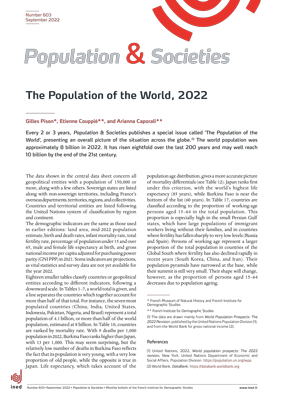INED publishes its table of the world population in 2022 and 2050
(The Population of the World - 2022)
Press release Published on 27 September 2022
Population and Societies no. 603, September 2022

Authors: Gilles Pison, Étienne Couppié and Arianna Caporali
Every 2 or 3 years, Population and Societies publishes a special issue called ‘The Population of the World’, presenting an overall picture of the situation across the globe. The world population was approximately 8 billion in 2022. It has risen eightfold over the last 200 years and may well reach 10 billion by the end of the 21st century. India is expected to have the world’s largest population by next year.
The world population is still growing. From 8 billion in 2022, it is forecast to approach 10 million by 2050. The pace of increase is slowing down, however. After peaking at 2% 60 years ago, annual growth has fallen by almost half (1% in 2022) and should continue to decrease until the population levels off at around 10 billion a century from now.
This slowdown is the consequence of declining fertility. Across the world today, women have 2.3 children on average versus 5 children in 1950. But this global average conceals large disparities across regions and countries. Fertility is lowest in South Korea (0.9 children per woman) and highest in Niger (6.7 children). In 2022, the world’s regions where fertility is still above 2.5 children include practically all of Africa, some countries of the Middle East, and the regions extending from Afghanistan to Pakistan and northern India. These are the regions where world population growth will be concentrated in years to come.
One of the major changes in future decades will be the considerable population growth in Africa. Despite the impact of AIDS, the continent’s population could almost triple by the end of this century, rising from 1.4 billion in 2022 to 3.9 billion in 2100. While 1 person in 6 currently lives in Africa, the proportion will probably be more than 1 in 3 a century from now.
With 1.43 billion inhabitants, China is the world’s most populous country, although India, which is not far behind (1.42 billion), should take the lead in 2023 since its population is growing faster due to higher fertility (2.0 children per woman on average versus 1.2 in China).
Published on: 29/09/2022








